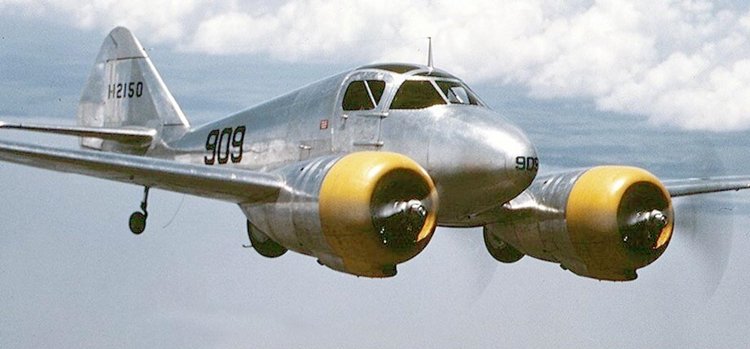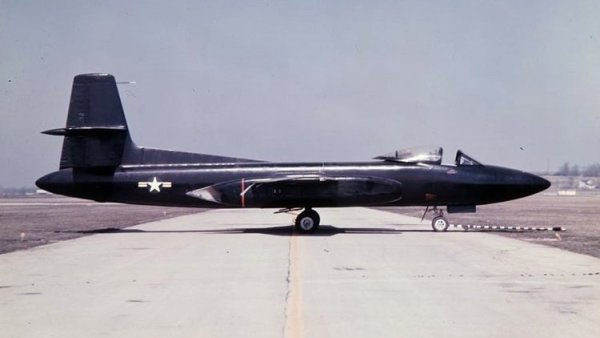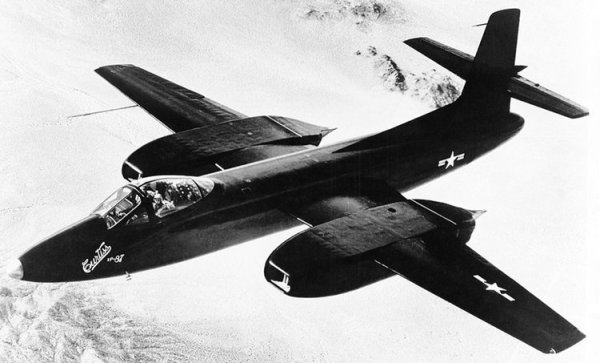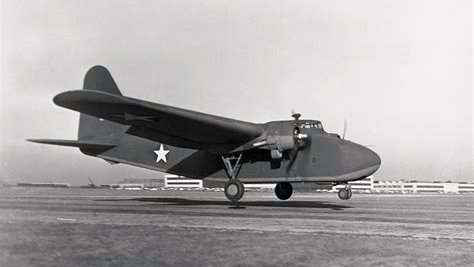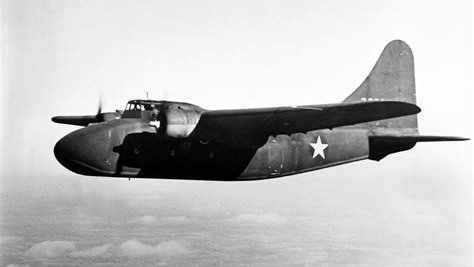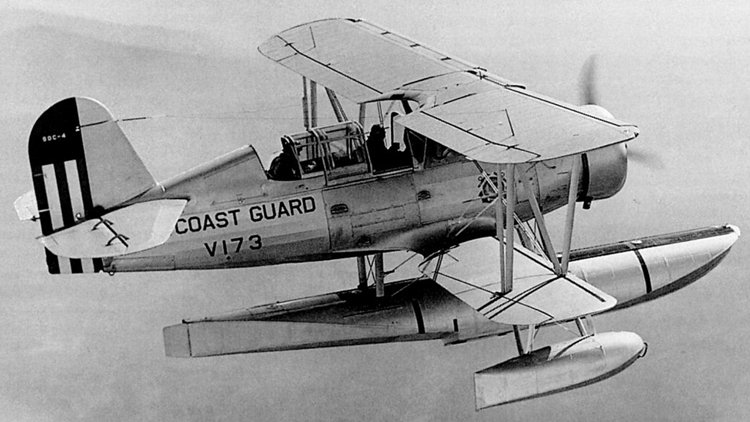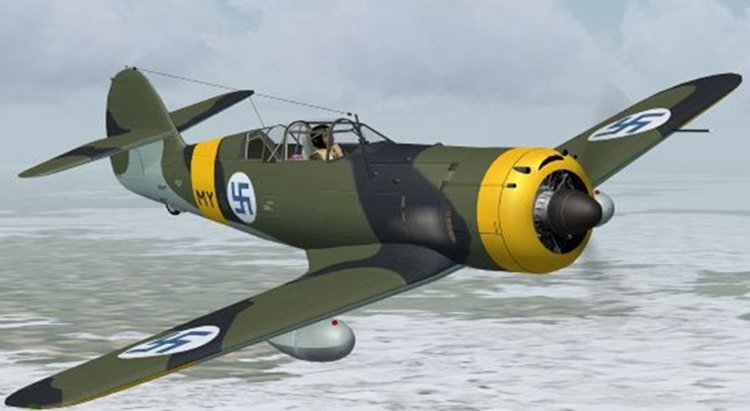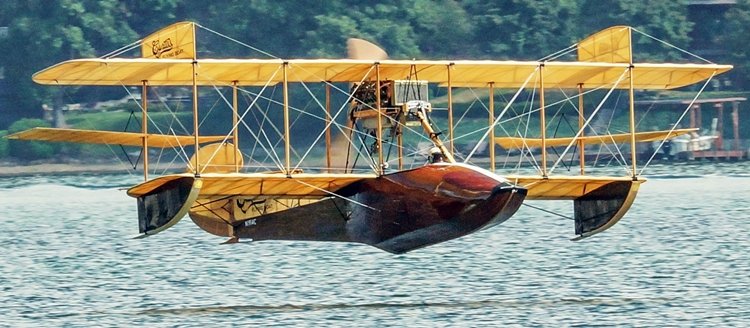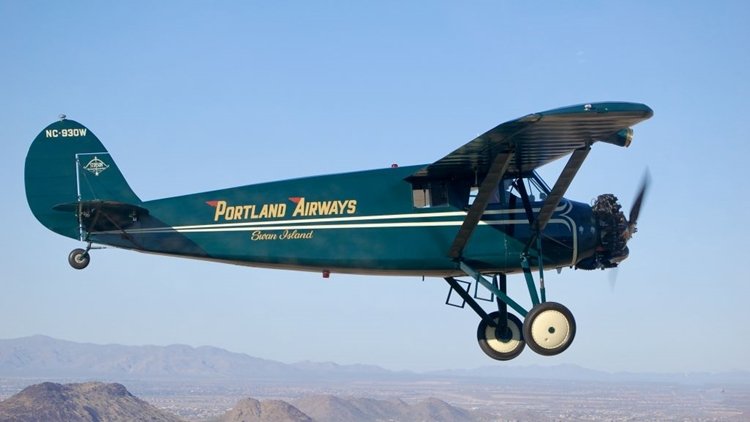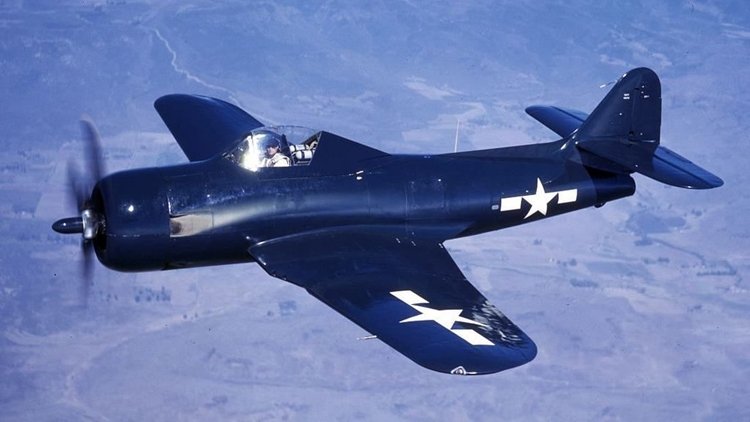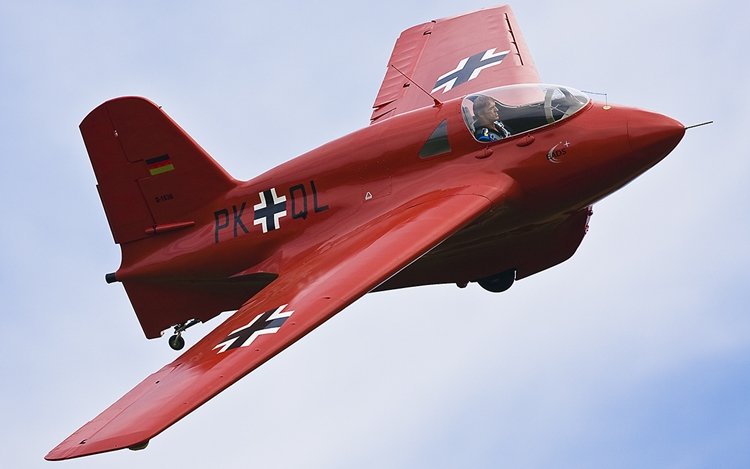-
Posts
7,576 -
Joined
-
Last visited
-
Days Won
67
Content Type
Profiles
Forums
Gallery
Downloads
Blogs
Events
Store
Aircraft
Resources
Tutorials
Articles
Classifieds
Movies
Books
Community Map
Quizzes
Videos Directory
Everything posted by red750
-
The Curtiss-Wright AT-9 Jeep was an American twin-engined advanced trainer aircraft used by the United States during World War II to bridge the gap between single-engined trainers and twin-engined combat aircraft. The AT-9 had a low-wing cantilever monoplane configuration, retractable landing gear and was powered by two Lycoming R-680-9 radial engines. Curtiss-Wright anticipated the requirement for this type of "high-performance" aircraft and designed the Curtiss-Wright CW-25, a twin-engined trainer, which possessed the takeoff and landing characteristics of a light bomber. Using the same basic design as the larger Cessna AT-17 Bobcat, the new CW-25 was designed to simulate the demands of multi-engined operations. The design featured a small layout, grouping two Lycoming R-680-9 radial engines forward and using a retractable tailwheel landing gear to achieve the performance necessary to meet the requirements of an advanced trainer. The single CW-25 prototype acquired for evaluation had a welded steel-tube fuselage structure with the wings, fuselage and tail unit fabric-covered. The first prototype Model 25 flew in 1941 and the production version entered service as the AT-9 in 1942. Named the "Fledgling" by Curtiss-Wright, it commonly became known as the "Jeep" in the United States Army Air Forces (USAAF).[2] The prototype CW-25 had a fabric-covered steel tube fuselage and fabric-covered wings and tail units, but production AT-9s were of stressed metal skin construction. The AT-9 was purposely designed to be less stable and proved to be difficult to fly or land, which made it particularly suitable for teaching new pilots to cope with the demanding flight characteristics of a new generation of high-performance, multi-engined aircraft such as the Martin B-26 Marauder and Lockheed P-38 Lightning. A total of 491 AT-9s were built before production ended and a new production run of 300 of the generally similar AT-9A commenced. Because of its difficult flying characteristics the AT-9 was not offered for sale to civilians after the war, although many non-flying examples were given to ground schools for training purposes. Number built: 792 (including prototype and AT-9A variant) Variants CW-25 Prototype with fabric covered fuselage and tail surfaces AT-9 Production aircraft with stressed-skin covering and two Lycoming R-680-9 radial engines, 491 built. AT-9A AT-9 with Lycoming R-680-11 radial engines and revised hydraulic system, 300 built before production ended in February 1943.
-
That's why it's in the SILLY aviation pictures thread,
-
Here is an interesting walk back through time to the glamorous age of flying, when meals were served on china, carved in front of you, and you could smoke to your heart's content. The golden age of flying.
-
The Curtiss-Wright XF-87 Blackhawk (previously designated the XP-87) was a prototype American all-weather jet fighter-interceptor, and the company's last aircraft project. Designed as a replacement for the World War II–era propeller-driven P-61 Black Widow night/interceptor aircraft, the XF-87 lost in government procurement competition to the Northrop F-89 Scorpion. The loss of the contract was fatal to the company; the Curtiss-Wright Corporation closed down its aviation division, selling its assets to North American Aviation. Only 2 prototypes built.
-
The Curtiss-Wright X-19, company designation Model 200, was an American experimental tiltrotor aircraft of the early 1960s. It was noteworthy for being the last aircraft of any kind manufactured by Curtiss-Wright. In March 1960 the Curtiss-Wright Corporation developed the X-100, a prototype for a new, vertical takeoff transport aircraft. The X-100 had a single turboshaft engine, which propelled two tilting-propellers, while at the tail swivelling nozzles used the engine's exhaust gases to give additional control for hovering or slow flight. Although sometimes classified as a tiltrotor aircraft, the design differed from the Bell VTOL XV tiltrotor designs. The X-19 utilized specially designed radial lift propellers, rather than helicopter-like rotors, for vertical takeoff and augmenting the lift provided by the wing structures. From the X-100 Curtiss-Wright developed the larger X-200, of which the United States Air Force ordered two prototypes designated the X-19A. The X-19 had fore and aft high-mounted tandem wings. Each wing mounted two 13 ft (4.0 m) propellers that could be rotated through 90 degrees, allowing the aircraft to take off and land like a helicopter. The propellers were driven by twin Avco Lycoming T55-L-5 turboshaft engines mounted in the fuselage.
-
The Curtiss-Wright C-76 Caravan (company designation CW-27) was an American all-wood military transport aircraft. The C-76 was intended as a substitute standard aircraft in the event of expected wartime shortages of light alloys. However, both prototype and production aircraft failed several critical flight and static tests, and after U.S. aluminum production proved sufficient for wartime defense requirements, orders for the C-76 were cancelled and production terminated. Number built 25 (11 prototypes, 5 production C-76, 9 revised YC-76A)
-
The Curtiss SOC Seagull was an American single-engined scout observation seaplane, designed by Alexander Solla of the Curtiss-Wright Corporation for the United States Navy. The aircraft served on battleships and cruisers in a seaplane configuration, being launched by catapult and recovered from a sea landing. The wings folded back against the fuselage for storage aboard ship. When based ashore or on carriers the single float was replaced by fixed wheeled landing gear. Curtiss delivered 258 SOC aircraft, in versions SOC-1 through SOC-4, beginning in 1935. The SOC-3 design was the basis of the Naval Aircraft Factory SON-1 variant, of which the NAF delivered 64 aircraft from 1940. The aircraft served as an important observation craft during WW2 for the U.S. Navy, although the Vought OS2U Kingfisher served in greater numbers. The SOC was ordered for production by the United States Navy in 1933 and first entered service in 1935. The first order was for 135 SOC-1 models, which was followed by 40 SOC-2 models for landing operations and 83 SOC-3s. A variant of the SOC-3 was built by the Naval Aircraft Factory and was known as the SON-1. The first ship the SOC was assigned to was the light cruiser USS Marblehead in November 1935; by the end of the decade, the SOC had replaced its predecessor throughout the fleet. Production came to an end in 1938. By 1941, most battleships had transitioned to the Vought OS2U Kingfisher and cruisers were expected to replace their aging SOCs with the third generation SO3C Seamew. The SO3C, however, suffered from a weak engine and plans to adopt it as a replacement were scrapped. The SOC, despite belonging to an earlier generation, went on to execute its missions of gunfire observation and limited range scouting missions. For more details of operational history, and the seven variants, click here. Specification below are for the SOC-1 floatplane variant.
-
-
Curtiss Twin P-40, a modified P-40 Warhawk incorporating twin engines mounted in nacelles above each wing and a rounded nose. The aircraft was supposedly a mock-up, but little actual information is known about it other than it existed; below is the only known photograph.
-
NNo explanation of the kangaroo or red tail with photo.
-
The VL Myrsky ("Storm") is a Finnish World War II fighter aircraft originally developed by Valtion lentokonetehdas for the Finnish Air Force. The models of the aircraft were Myrsky I, Myrsky II, and Myrsky III. It was designed by Edward Wegelius, Martti Vainio and Torsti Verkkola who worked at Valtion lentokonetehdas. The decision to start developing a new fighter for the Finnish Air Force was based on experience gained before the Winter War: in the "arms race" leading up to a war, smaller nations can have difficulty purchasing top-of-the-line fighters without a significant political cost. The Finnish Air Force requested preliminary proposals for a domestic fighter from State Aircraft Factory (Valtion Lentokonetehdas) in early 1939, before the Winter War. State Aircraft Factory prepared five alternative proposals by May 1939. After that, The Ministry of Defence ordered the fighter design from State Aircraft Factory in June 1939. The preliminary design was made by the aircraft-designer trio Arvo Ylinen (head of the design-bureau), Martti Vainio (aerodynamics), and Torsti Verkkola (structural design). Edward Wegelius was appointed head of the design department of the State Aircraft Factory when Ylinen later moved on to the Helsinki University of Technology in August 1940. VL did not appoint any main constructor to its products, such as the German aircraft manufacturers did. Due to difficulties obtaining duraluminium, the wings were made out of plywood and the fuselage was metal structure with a fabric and plywood skin. The planned Bristol Taurus III engine was not available due to war, so a Pratt & Whitney R-1830 (civil Twin Wasp) was chosen. Availability of this engine was also problematic, so the first prototype used an R-1830-S3C3-G, while later prototypes and production fighters used less-powerful SC3-Gs. Finland bought these engines from German war booty stocks. The first Myrsky prototype flew on 23 December 1941. The prototype was fully functional, but too heavy. After some modifications they soon had three new prototype aircraft. The test flights showed some structural problems during high-speed tests. All three prototypes were destroyed during test flights; two test pilots died, one was seriously injured. The culprit was found to be aeroelastic flutter, which was a poorly known phenomenon at the time. Resolving the flutter problem took almost a year. Series production started in autumn 1942 far before German deliveries of Messerschmitt Bf 109 had begun in 1943. The series production version was called the Myrsky II. 47 Myrsky IIs were built and together with the Myrsky I version and Myrsky prototype the production amounted to 51 in all. Although the aircraft met the specifications set for it, it did not fulfill all expectations due to structural problems. or operational history, click here. The Myrsky III was ordered in spring 1943, but none were built. Variants Myrsky Prototype, 1 built Myrsky I Preproduction aircraft, 3 built Myrsky II (Specifications below) Series-production aircraft, 47 built Myrsky III 10 being built but cancelled
-
(No to be confused with the Curtiss SOC Seagull of WW2) The Curtiss Seagull was a civil variant of the Curtiss MF flying boat trainer produced from 1918, the civil aircraft having a 119 kw (160 hp) Curtiss C.6 six-cylinder in-line engine in place of the V-8 unit in the military variants. The MF was one of a long line of flying boats produced for the US services following the entry of the United States into World War I, when flying boats were required for patrolling coastal waters to prevent German submarine operations. Two examples of the Seagull came to Australia. Seagull G-AUCV (c/ n MF.419/28) was registered in 1921. It left Double Bay, Sydney, NSW on 13 March 1921 and made an epic flight to and from Tasmania, this being described as the First Aerial Reconnaissance in Australia, the pilot being Capt Andrew Lang(said to be shot down by the Red Baron during World War I, the operation being financed and promoted by Lebbeus Hordern. Cameras were carried on board in order that aerial photographs could be taken of the coastline. The auxiliary yacht ‘Acielle’ accompanied the expedition and acted as a tender for the Seagull. The flight was made in short stages, the first night being at the Shoalhaven River, near Nowra, NSW, thence to Jervis Bay, Moruya, down the coast to Eden and Marlo where the Victorian Premier, Mr Lawson, was met. Later he was taken for a flight over the area. Stops were made and local flights were made with passengers. From Welshpool it flew to Lady Barren and then across the Tasman, landing on the Tamar River close to Cataract Gorge. The return flight commenced on 19 June and the aircraft arrived at Double Bay on 4 July 1921. The bottom photo below shows the aircraft on the Tamar River. For more details of these aircraft click here.
-
The Stinson Junior was a high-winged American monoplane of the late 1920s, built for private owners, and was one of the first such designs to feature a fully enclosed cabin. Stinson Aircraft had introduced their large high-winged six-seat SM-1 Detroiter in 1927. The SM-1 was sold successfully to airlines and other commercial operators, but it was too large to appeal to private owners. Stinson therefore redesigned the aircraft with shorter span wings, shorter fuselage and a choice of less powerful engines as the SM-2 Junior. The aircraft was a strut-braced high-wing monoplane with a sturdy outrigger undercarriage which was braced against the wing support struts and the initial 110 h.p. Warner Scarab engine was normally left uncowled. The first SM-2 flew in mid-1928 and deliveries commenced that year. Later versions of the SM-2 had higher-powered engines of between 165 h.p. and 225 h.p. The design was further developed to produce the more powerful and heavier SM-7 and SM-8 models which were full four-seaters and these were also used by commercial firms. The Junior R of 1932 had a deeper fuselage and a low-set stub wing to mount the undercarriage and wing struts. The various Stinson Junior models were in production between 1928 and 1933, being bought by both wealthy private flyers and commercial enterprises. A total of 321 Juniors were built, of which 27 survived in 2001 and several of these were airworthy in private hands. In 1977, the Experimental Aircraft Association painted an SM-8A "Spirit of EAA", and flew a cross-country tour as the support plane with a "spirit of St. Louis" replica as part of the 50th anniversary of Lindbergh's Trans-Atlantic crossing. Variants SM-2 Warner Scarab 110 h.p. SM-2AA Wright J6-5 165 h.p. SM-2AB Wright J5 220 h.p. SM-2AC (Specifications below) Wright J6-7 225 h.p. SM-2ACS floatplane version of the SM-2AC SM-7A Wright J6-9 300 h.p. SM-7B Wasp Junior 300 h.p. SM-8A Lycoming R-680 215 h.p. SM-8B Wright J6-7 225 h.p. SM-8D Packard DR-980 diesel 225 h.p. Junior R Lycoming R-680 215 h.p. and deeper fuselage. 28 Units built Junior R-2 Lycomong R-680-BA 240 h.p. 3 Built. Junior R-3 as R-2 with retractable undercarriage 3 Units built.[5] Junior R-3-S Lycoming R-680-6 245 h.p. Junior S Lycoming R-680 215 h.p. with fully cowled engine Junior W generally similar to the SM-7B, powered by a Wasp Junior engine
-
The Ryan FR Fireball was an American mixed-power (piston and jet-powered) fighter aircraft designed by Ryan Aeronautical for the United States Navy during World War II. It was the Navy's first aircraft with a jet engine. Only 66 aircraft were built before Japan surrendered in August 1945. The FR-1 Fireball equipped a single squadron before the war's end, but did not see combat. The aircraft ultimately proved to lack the structural strength required for operations aboard aircraft carriers and was withdrawn in mid-1947. Design of the FR-1 began in 1943 to a proposal instigated by Admiral John S. McCain Sr. for a mixed-powered fighter because early jet engines had sluggish acceleration that was considered unsafe and unsuitable for carrier operations. Ryan received a contract for three XFR-1 prototypes and one static test airframe on 11 February 1943 with the first two prototypes delivered in 14 months. Another contract was placed for 100 aircraft on 2 December 1943 and a later contract on 31 January 1945 increased the total of FR-1s on order to 700. The XFR-1 was a single-seat, low-wing monoplane with tricycle landing gear. A 1,350-horsepower (1,010 kW) Wright R-1820-72W Cyclone radial engine was mounted in the fighter's nose while a 1,600 lbf (7,100 N) General Electric I-16 (later redesignated as the J-31) turbojet was mounted in the rear fuselage. It was fed by ducts in each wing root which meant that the wing had to be relatively thick to house the ducts and the outward-retracting main landing gear. To simplify the fuel system, both engines used the same grade of avgas. Two self-sealing fuel tanks were housed in the fuselage, one of 130 US gallons (490 L; 110 imp gal) and the other of 50 US gallons (190 L; 42 imp gal). The cockpit was positioned just forward of the leading edge of the wing and the pilot was provided with a bubble canopy which gave him excellent visibility. The XFR-1 had the first laminar flow airfoil in a navy carrier aircraft. The Fireball was armed with four .50 in (12.7 mm) M2 Browning machine guns with 300 rounds per gun. They were mounted in the center section of the wing, immediately outboard of the air intakes for the jet engine. Four 5-inch (127 mm) rockets could be carried under each outer wing panel and two hardpoints were provided under the center section for 1,000 lb (454 kg) bombs or 100 US gal (380 L; 83 imp gal) drop tanks. Armor plates were provided in front and behind the pilot's seat and for the oil cooler. For more details of design, development and operational history, click here. Variants XFR-1 Military designation of the prototype Model 28 aircraft, three built. FR-1 Fireball Single-seat fighter aircraft, 66 built. (Specifications below) FR-2 Conversion with a Wright R-1820-74W replacing earlier piston engine, one aircraft modified. FR-3 Proposed variant with a General Electric I-20 replacing earlier jet engine; never built. XFR-4 Variant with Westinghouse J34; one built.[7]J34-WE-12.
-
Thank you F.V.
-
This is the photo I referred to in the opening post. Does anyone on this site own or have owned this aircraft?
-
Thank you.
-
Thanks for that. The photo was that of an Australiann Lightwing Ga-55. There is nothing on the Hughes Engineering website more recently that 2021. Have they gone out of business?
-
I was going through some of my photos and I came across one that had a 2-3 format rego, rather than the normal 2-4 format. Can a rego of, say, 25-0999 be shown on the aircaft as 25-999? In other words, can the 0 in that location be dropped? (Note, that's not the real number in question.)
-
The Messerschmitt Me 163 Komet is a rocket-powered interceptor aircraft primarily designed and produced by the German aircraft manufacturer Messerschmitt. It is the only operational rocket-powered fighter aircraft in history as well as the first piloted aircraft of any type to exceed 1,000 kilometres per hour (620 mph) in level flight. Aproximately 370 units were produced. Development of what would become the Me 163 can be traced back to 1937 and the work of the German aeronautical engineer Alexander Lippisch and the Deutsche Forschungsanstalt für Segelflug (DFS). Initially an experimental programme that drew upon traditional glider designs while integrating various new innovations such as the rocket engine, the development ran into organisational issues until Lippisch and his team were transferred to Messerschmitt in January 1939. Plans for a propeller-powered intermediary aircraft were quickly dropped in favour of proceeding directly to rocket propulsion. On 1 September 1941, the prototype performed its maiden flight, quickly demonstrating its unprecedented performance and the qualities of its design. Having been suitably impressed, Nazi officials quickly enacted plans that aimed for the widespread introduction of Me 163 point-defence interceptors across Germany. During December 1941, work began on the upgraded Me 163B, which was optimized for large-scale production. During early July 1944, German test pilot Heini Dittmar reached 1,130 km/h (700 mph), an unofficial flight airspeed record that remained unmatched by turbojet-powered aircraft until 1953. That same year, the Me 163 began flying operational missions, being typically used to defend against incoming enemy bombing raids. As part of their alliance with Empire of Japan, Germany provided design schematics and a single Me 163 to the country; this led to the development of the Mitsubishi J8M. By the end of the conflict, roughly 370 Komets had been completed, most of which were being used operationally. Some of the aircraft's shortcomings were never addressed, and was less effective in combat than predicted. Capable of a maximum of 7.5 minutes of powered flight, its range fell short of projections and greatly limited its potential. Efforts to improve the aircraft were made (most notably the development of the Messerschmitt Me 263), but many of these did not see actual combat due to the sustained advancement of the Allied powers into Germany in 1945. For a dedicated interceptor aircraft that achieved operational status, the track record of the Me 163 is somewhat underwhelming, having been credited with the destruction of between nine and 18 Allied aircraft against ten losses. Aside from the actual combat losses incurred, numerous Me 163 pilots had been killed during testing and training flights. This high loss rate was, at least partially, a result of the later models' use of rocket propellant, which was not only highly volatile but also corrosive and hazardous to humans. One noteworthy fatality was that of Josef Pöhs, a German fighter ace and Oberleutnant in the Luftwaffe, who was killed in 1943 through exposure to T-Stoff in combination with injuries sustained during a failed takeoff that ruptured a fuel line. Besides Nazi Germany, no nation has ever made operational use of either the Me 163 specifically, or rocket planes in general. A few captured Me 163s were flown for evaluation and research purposes. Australia Me 163B, Werknummer 191907 was part of JG 400, captured at Husum and was shipped to the RAE. It was allocated the RAF Air Ministry number of AM222 and was dispatched from Farnborough to No. 6 MU, RAF Brize Norton, on 8 August 1945. On 21 March 1946, it was recorded in the Census of No. 6 MU, and allocated to No. 76 MU (Wroughton) on 30 April 1946 for shipment to Australia. For many years this aircraft was displayed at RAAF Williams Point Cook, but in 1986, the Me 163 was transferred to The Australian War Memorial for refurbishment. It was stored at the AWM Treloar Technology Annex Mitchell, refurbished and reassembled, and was later put up for display together with a Messerschmitt Me 262A-2a, Werknummer 500200 (AM81). For details of the development, operational history and models of the Me-163, click here.
-
The Sud-Ouest SO.6000 Triton was an early experimental French jet aircraft. It has the distinction of being the first indigenously-designed jet-powered aircraft to be flown by the nation, having been designed and manufactured during the 1940s by the French aircraft construction consortium SNCASO. Work on the French jet aircraft initiative had begun in secret during the Second World War, and harnessed research retrieved from Nazi Germany. Almost immediately after the end of the conflict, the French government issued a requirement for a batch of five prototype jet aircraft to be developed by French industry. To avoid delaying the overall project, it was decided to use the German-designed Junkers Jumo 004-B2 engine after severe development issues were encountered with the indigenously-developed Rateau-Anxionnaz GTS-65 turbojet engine. The British Rolls-Royce Nene turbojet engine was also adopted for some of the prototypes. On 11 November 1946, the first prototype performed its maiden flight, flown by test pilot Daniel Rastel. This feat was viewed by the government as being an important, and public, advancement in the capabilities of French industry and military capability. A total of five aircraft were produced for the test programme, including one for static testing only. Despite multiple aircraft been built and successfully flown, further development of the SO.6000 was abandoned following the rapid emergence of more advanced jet-powered fighter aircraft.
-
The Grumman XF10F Jaguar was a prototype swing-wing fighter aircraft offered to the United States Navy in the early 1950s. Although it never entered service, its research paved the way toward the later General Dynamics F-111 and Grumman's own F-14 Tomcat.



